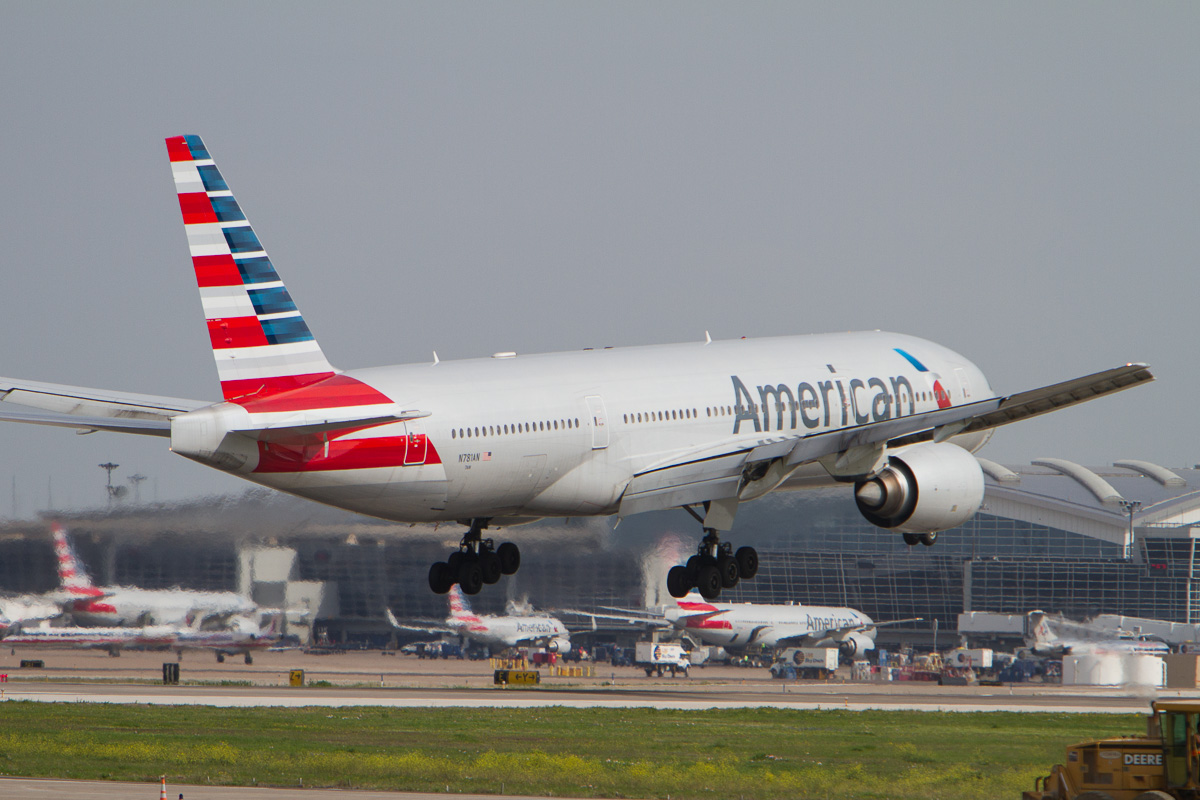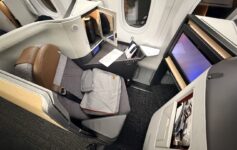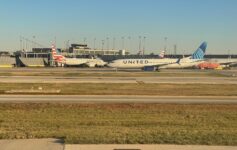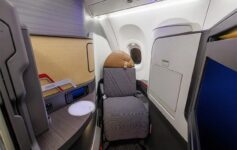
Disaster was narrowly avoided when an American Airlines 777 crossed the wrong runway at New York (JFK) and nearly collided with a Delta Air Lines 737. With all the safeguards in place, it is a reminder that human error can still have catastrophic consequences.
American 777, Delta 737 Jets Nearly Collide At New York JFK
At 8:45 pm ET on Friday, January 13, 2023, an American Airlines 777-200ER crossed runway at 4L at JFK at the same moment a Delta Air Lines 737-900 was cleared to takeoff on the same runway. The American 777 was traveling to London (LHR) under AA106 while the Delta 737 was traveling to Santo Domingo (SDQ).
As first noted by @xJonNYC, thankfully an air traffic controller noticed the impending crisis and cancelled takeoff clearance.
Two audio excerpts from @liveatcpic.twitter.com/4ruAWgVO4b
— 🇺🇦 JonNYC 🇺🇦 (@xJonNYC) January 14, 2023
Air Traffic Controller: Sh*t! Delta 1943, cancel takeoff clearance. Delta 1943, cancel takeoff clearance.
Delta Pilot: Rejecting.
Delta Pilot: All right, whew, Delta 1943.
Air Traffic Controller: Delta 1943, are you able to taxi, or do you need a couple of minutes to run checks?
Delta Pilot: Yeah we can get off the runway, Delta 1943.
Check out this helpful illustration–
Here’s another one, illustrated by FlightRadar24:
— Casey Wade (@CaseWade) January 14, 2023
Meanwhile, the following conversation took place between ATC and the AA pilot:
American Pilot: The last clearance we were given, we were cleared to cross, is that correct?
Air Traffic Controller: American 106 heavy, we’re departing runway 4L, I guess we’ll listen to the tapes, but you were supposed to depart runway 4L, you’re currently holding short of runway 31L.
The American Airlines flight took off for London, landing 30 minutes late. The Delta flight was cancelled (it is not clear why).
How Could This Have Been Avoided?
An investigation has been launched and we can make no definitive statements yet, though ATC audio and flight path illustrations suggest pilot error on the part of the American Airlines 777 flight deck. That aircraft was ordered to cross 31L in order to depart from 4L, but crossed 4L instead.
It is possible a collision could have been avoided even if the Delta flight had not aborted takeoff, but it is sobering to note how little distance separated the two aircraft…only 1,000 feet. The 777-200 is 210 feet long.
121Pilot, our resident commercial airline pilot on Live and Let’s Fly, recently discussed the importance of airmanship. I think it merits repeating here as his words are almost haunting in light of this incident:
What about good judgment? How do we teach that? First and foremost, we as professional pilots have to recognize that we are just that, professionals. This means a dedication to our craft that goes beyond simply showing up to work day after day. It means studying accident reports to learn from the mistakes of others. It means thinking through the various things that can and have gone wrong and trying to figure out in advance how we might bring those events to a successful conclusion. It means we must take responsibility for ensuring that no matter what we have the best possible chance of bringing our aircraft and passengers safely home.
Absolutely fundamental to aircraft safety is correctly hearing, repeating, then executing air traffic control instructions. But it is good judgment that can prevent and effectively react to things going wrong…and also recognize when something seems off. Wouldn’t one of the American Airlines pilots have noticed (either visually or via audio) that most takeoffs were occurring on 4L?
> Read More – Airmanship: What Pilots Need Most
CONCLUSION
What appears to be a near-miss was avoided thanks to decisive action by an air traffic controller and Delta 737 pilot. While we cannot definitively say that absent such intervention there would have been a deadly accident, this is the sort of risk you never want to gamble with.
Thoughts of the 1977 KLM – PanAm Tenerife incident dance through my head as I think about this incident (different fact pattern, of course, but for the sheer terror of recognizing the disaster as it occurs). I am so grateful that disaster was avoided and hope that from this incident will come additional safeguards and of course, airmanship.
image: Grant Wickes




Who caused the AA plane to make the error. Was it the woman AA pilot or the other AA pilot?
“Hearing, repeating and executing ATC instructions”. After listening to the recording Delta did exactly that & on time. Thank goodness. AA 106 response to ATC was somewhere between inattentive, lackluster and bewilderingly.
Many have commented on the fact it was close, but maybe still okay. Judging from the Delta pilot’s voice I question that he felt slamming on the brakes at 115 mph was anything but okay.
Where did you see that he had reached a speed of 115mph? From accounts I am reading the plane was in its roll for no more than 5-8 seconds. By the time you would reach 115mph he would have been far past the taxiway where AA was. While it seems like AA was indeed hugely mistaken we can also say the system worked as it should and averted a potential disaster from happening.
Whatever the speed was you can clearly hear in the pilots voice the shock of seeing a 777-200 cross a runway after they had already begun their takeoff roll.
Clearly the system worked thanks to an extremely alert air traffic controller.
It’s obvious the AA pilots weren’t paying attention, it’s also obvious the AA pilots didn’t check to make sure the runway was clear and safe to cross something every pilot is taught back in flight school. The pilots of the 777-200 were completely unaware they were crossing a runway with an aircraft taking-off. Both the captain and first officer need to answer some basis questions like why and how they both failed to notice the Delta Air Lines 737 taking off?
Which brings into question if ATC had not noticed AA’s mistake would the Delta pilots have had enough time to react and avoid the collision by the time they would have noticed the the 777-200 crossing the runway?
@Stuart ABC 7 around noon reported 115 mph. Just glad everybody is fine.
After listening to the entire ATC encounter both tower and ground AA 106 heavy was told to cross runway 31L at kilo when the AA pilot responds and he has a bit of an attitude when stated the last clearance he was given was to cross. Then the controller states we are departing runway 4L we will listen to the tapes but you are currently holding short of runway 31L. These AA pilots didn’t even know they were holding short of runway 31L, from listening to the entire encounter is appears as though the AA pilots thought they were holding short of runway 4L and had done nothing wrong.
This flight was going to LHR how did 3 pilots all loose situational awareness to the point none of them realized they were lined up holding short of runway 31L instead of runway 4L? There are a lot of questions that need to be answered as to what was going on on the flight deck of AA106.
The DL flight was cancelled because the plane needs to be inspected, particularly the brakes. They were used to stop a fully loaded plane (with fully loaded fuel), which is something they’re not normally used for. Plus, there is also the psychological impact on the pilots of a near miss incident. It’s not a simple “walk it off” type of incident.
I’m guessing some uniforms and cockpit seats needed to be cleaned, too.
The weight & speed of the stop had to have been incredible stress on the tires. No pilot here but I think that too would be important to check out.
Like Matthew, this immediately brought back visions of Tenerife and the KLM/Pan Am disaster. From what little I have heard, the AA crew seemed oddly detached and almost seemed to not understand what had almost happened. Perhaps it was confusion or embarrassment. I don’t know. But accolades to the Delta cockpit crew and the Air Traffic Controller who saw this unfolding as was able to stop it.
Plenty of blame to go around including:
a) multiple taxiways at JFK which range literally “A” to “Z” with multiple subset like KE & KF & KG
b) intersecting runways like L31 & R31 with 22R
c) a radio frequency crammed with multiple instructions and inadvertent talk overs
d) the same frequency filled with enough static, interference, and flutter to fail a hearing test
e) FAA obsession with “Pushing Tin” as quickly as possible
f) multiple airlines wanting to arrive & depart at the same HUB airport at the same time
g) etc, etc, etc
Let the NTSB investigate!!!
JFK, AA, & DL may not like the conclusions, but the life of every PAX is hanging on the recommendations…
Even more concerning is how American was allowed to depart after a major incident! Surely all i vo,lved should be immediately stood down till basic nvestigation done. AA pilots would have to bw affected by what happened! Would never have been allowed to go in Australia!!!!